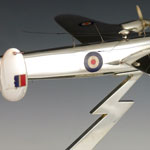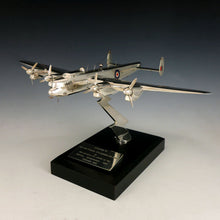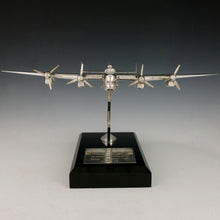The Battle of the Beams - A George VI Model of an Electronic Warfare Lancaster, 1949
Adding product to your cart
Overall: 23cm (9.25in) x 30cm (12in) x 42cm (16.5in)
Nickel plated bronze model of an Avro Lancaster bristling with experimental avionics, raised on a lightning bolt support and ebonized plinth. Made by 90 Group’s S.D.U., and bearing presentation plaque inscribed 'Presented to Air Vice Marshal E.B. Addison, C.B., C.B.E., by the officers and airmen of the Signals Development Unit February 1949’
Air Vice Marshal ‘Addy’ Addison was a central figure in Britain’s electronic warfare campaign during the Second World War; firstly in the Battle of the Beams,1940-41, and afterwards in Bomber Command’s strategic bombing of Germany and other targets in Occupied Europe, 1942-45.
In the 1930s the new generation of multi-engined aircraft gave rise to the mantra ‘the bomber will always get through’, leading to a race for navigational superiority and accuracy in bombing. The R.A.F. concentrated its efforts on celestial navigation - (a complete failure in bombing terms as revealed by the Butt report of 1941) - while the Luftwaffe developed radio navigation to effect. By 1940 the Luftwaffe were using a VHF blind-bombing system, Knickebein (codenamed ‘Headache’ by the British) to guide their bombers on to targets. Knickebein (being the legendary raven of German mythology with the ability see over long distances, but also more prosaically a word meaning crooked leg from the shape of the aerials) relied on a distance and direction beams, the crossing of which initiated automatic release of Nazi bombs with alarming accuracy.
Ultra intelligence from decrypted Enigma messages mentioning ‘bombing beams’ soon reached Churchill who ordered urgent action to counter Knickebein. The Air Ministry’s scientists led by R.V. Jones who had inspected a receiver set in a downed Heinkel, teamed up in October 1940 with the newly formed 80 (Signals) Wing under Addison, then a wing commander just returned from the Middle East. Both organisations were given the highest priority, and worked under the immediate control of the Air Ministry but kept in close touch with Fighter Command at Bentley Priory. The ‘Battle of the Beams’, as Winston Churchill termed it, was thus joined. 80 Wing’s motto ‘Confusion to Our Enemies’ was effected with jammers transmitting noise (codenamed Aspirin) on the Knickebein frequencies.
The Luftwaffe countered with the more powerful X-Gerät that was used to effect in the attacks on Birmingham, Coventry and Wolverhampton (codenamed Operation Moonlight Sonata by the Nazis). Jones guessed the beam layout but the modulation frequency had been measured inaccurately with the result that Luftwaffe destroyed the centre of Coventry on the night of 14/15 November. Once again a crashed Heinkel provided answers and British jammers were modified. Thereafter X-Gerät was jammed by 80 Wing and the accuracy of German bombing declined until the Blitz ended in May 1941, when the Wehrmacht looked east in preparation for the attack on the Soviet Union.
On 23/24 April 1942, the Luftwaffe began a new campaign against U.K. targets (the Baedeker Blitz) with a heavy raid on Exeter, followed by a series of attacks on other provincial cities. Scientific intelligence gave about six weeks' warning that these raids would employ X-Gerät with a new supersonic modulation frequency. 80 Wing was able to jam but for intelligence reasons was briefed not to on all but essential targets. When finally permitted, 80 Wing jammed and reduced the 50% success rate of bombs on target of the early Baedeker raids to 13%. R.V. Jones estimated that the delay in allowing Addison’s Wing to begin jamming cost about 400 lives and another 600 serious injuries.
By December 1943 the work of 80 Wing had reached such proportions that 100 (Bomber Support) Group was formed under Addison’s command and with the motto ‘Confound and Destroy’. His headquarters at Bylaugh Hall, a requisitioned Victorian mansion, provided a central location from which to administer the group's eight airfields in north Norfolk. 100 (BS) Group operated approximately 260 aircraft in 14 squadrons. These in included Halifaxes, Stirlings, Wellingtons, Fortresses and Liberators carrying radio-countermeasures. The rest were De Havilland Mosquitoes equipped with electronic 'homers' to detect Luftwaffe night fighters and either shoot them down or disrupt their missions against the bomber streams. Other 100 Group Mosquito intruders would patrol around Luftwaffe airfields ready to attack night fighters as they landed. This constant harassment resulted in ‘Moskito Panik’ amongst Luftwaffe night fighter crews.
Addison continued to command 100 Group until its disbandment on 17 December 1945. He and A.V.M. Donald Bennett of the Pathfinder Force are said to be the only Second World War Group commanders, who served full terms, not to receive knighthoods. General der Jagdflieger Adolf Galland, however, recognised their contributions - ‘The combination of the Pathfinders' operations, the activities of No. 100 Group, the British advantage in radar, jamming and Window techniques, combined with intelligent attacking tactics, as well as the discipline and bravery of the R.A.F. crews, have been remarkable. We had our (sic) severe problems in trying to defend Germany in the air’ (Lancaster - The Biography).
Air Vice Marshal Edward Barker ‘Addy’ Addison, C.B., C.B.E., F.I.E.E. (1898-1987) served with the Royal Flying Corps and R.A.F. during the First World War. He studied at Sidney Sussex College, Cambridge and re-entered the R.A.F. in 1921. His studies continued at the École Supérieure d'Électricité of Paris in 1927. In April 1946 he was appointed as A.O.C., No. 90 (Signals) Group with his headquarters at R.A.F. Medmenham. A.V.M. Addison retired from the R.A.F. in 1955 as Director-General of Signals to a civilian career. At his final retirement in 1975 he was Director of Intercontinental Technical Services. In 1977 he appeared in the BBC’s The Secret War episode ‘The Battle of the Beams’.








